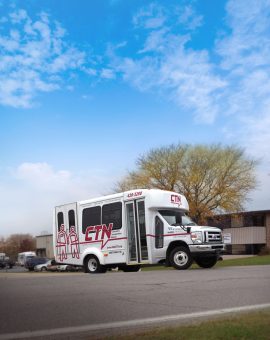Transportation needs in our community
February 21, 2022
The following piece by Justin Clupper appeared in the February 17, 2022 edition of The Journal Gazette.
Few could argue that Fort Wayne is an auto-centered community; for more than 90 percent of households, having a car isn’t an issue. We don’t worry about getting to work, school, the grocery, church, or doctor appointments. We hop in, start the ignition and go.
Every 10 years Citilink, and community leaders produce a Transit Development Plan (TDP). This plan helps shape transportation goals for the next decade, like changes in routes or stops. It also identifies the gaps in transportation.
The most recent TDP found more than 8,000 households in Fort Wayne without a car. That’s 8,000 families who worry every day how they will get where they need to go. The number of households with only one vehicle is substantially higher.
As the leader of Community Transportation Network (CTN), I consistently discuss transportation gaps in our community, and how we’re different from Citilink. Citilink operates the public bus system, while CTN uses 28 red and white vans for pre-scheduled trips to help low-income seniors, people with disabilities. We work together often and one fact we agree on, is that thousands lack dependable transportation to everyday activities.
This past summer a donor asked a pointed question about the real need for transportation in our community: “If transportation is such a problem, why isn’t United Way and other groups adopting it as a pillar?”
That’s a fair question. Some organizations have championed transportation as a major pillar. AWS Foundation and St. Joseph Community Health Foundation have prioritized transportation since their beginnings. Many others have recognized transportation as a barrier to other basic needs.
Consider United Way of Allen County. This summer UWAC prioritized four areas it will intentionally address in the coming years: educational opportunities, food security, housing stability, and mental health access. Though transportation is not one of the four, it remains a barrier to each.
People need a ride to school, to the grocery store, to work, and to mental health resources. On average, more than 6% of CTN’s medical transportation is for mental health support. And last year we saw a 35% increase when we started offering free rides to the grocery. Citilink continually hears about the need for later service hours to accommodate rides to work, but without increased funding (and greater local control over public transportation funding) cannot grow this service.
To move our community forward, we need to have the capacity to move people. Prior to the pandemic, CTN provided over 27,000 medical rides and more than 17,000 rides to work. Based on information from the state and our partner agencies, that number would easily double if CTN and other transportation providers had the capacity to serve. To grow that capacity, we need help. We need people who want to drive for us. We could hire 10 drivers today and keep them all busy.
We’re also working to develop stronger funding relationships within the community. Individuals, companies, and families join us every day to help CTN ease the burden of transportation and drive community. We can’t do it alone. While the average cost of a ride ranges from $40 – $50, we are able to keep our fees a fraction of that cost because of those who come alongside and support us.
As I share with business and community leaders about transportation gaps, the next response is usually that we need to expand Citilink’s services. However, CTN provided over 100,000 trips before the pandemic, and Citilink provides 1.3 million trips, we are the area’s most productive private and public non-profit transportation agencies. Transportation challenges cannot be solved by one entity; expanded public transportation isn’t a near-term reality. To gain more riders, there needs to more state and federal funding. However, to gain the funding, there must be more riders. Truly, a chicken or the egg conundrum.
The next time you hop in your car and start the ignition, before you move forward, think about the thousands of households who have no transportation access and ask how you can help. Remember that better transportation options support better education, better jobs, and better health. It’s a priority for us all.

